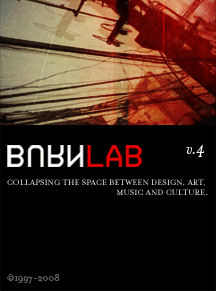Although he doesn't speak specifically about Absolute Body Control or any of Ivens' other projects, I found it interesting that Simon Reynolds posted an article he wrote back in 1990 for the New York Times about Electronic Body Music - or "Industrial Disco" as he puts it - just this week on his Rip it Up and Start Again blog. The blog itself is a bloody erratic beast to navigate, but an interesting companion to his book of the same name, and overflows with information and insight about some of the most important music ever made. Scroll about 45% down the page for the full Industrial Disco article. A few choice paragraphs are cut and pasted below.
Nobody can agree on what to call the kind of music that Front 242 play: "industrial disco", "dancecore", "Euro body music", are just some of the names that practioners disown more frequently than pledge affiliation. But after ten years as the soundtrack for a burgeoning cult scene, this sound may be on the verge of going overground. The recent grim turn in world events could even help it on its way, as clubgoers react against the New Age "positivity" of current dance music and turn to something more in tune with the chaos of the age. For industrial disco is danceable but it isn't funky, and it doesn't correspond to most people's idea of "fun". If disco is escapist, industrial disco is "no escape"-ist. Drawing on media images of conflict and calamity, it doesn't so much document as amplify the tension and chaos of the outside world.
(Um... does all of this sound oddly familiar? If not, see The New Black and Uneasy Listening Music. )
Industrial disco's musical "roots" (the term seems inappropriate for music so inorganic and assembled) lie in the Eurodisco sound invented in the late Seventies by producer Giorgio Moroder and popularised with tracks like Donna Summer's "I Feel Love". Moroder's aim was to create a pulse-based dance music that would be easier for white people to shake their stuff to than funk's tricksy syncopation. Another critical influence is the early Eighties German group D.A.F., who replaced the flash and dazzle of symphonic disco with a precise and rigorous grid of synth pulses. D.A.F.'s version of dance was less about flamboyant self-expression and more about "absolute body control" (as one of their songs put it).
(And I thought Solvent and Sister Machine Gun taking their names from Skinny Puppy songs was a new idea!)
The "industrial" side to the genre originates in a term adopted by one of the factions that emerged in the aftermath of punk. "Industrial" groups like Cabaret Voltaire and Throbbing Gristle beleived that punk was about disturbing the individual listener, rather than rallying youth in raucous solidarity behind political slogans. Challenging the listener involved tampering with traditional musical structures, experimenting with new technology, and exploring subject matter that undermined comforting truths rather than shored up a consensus. These groups combined traditional avant-garde techniques (tape loops, found sounds, electronics) with the new spatial possibilites opened up by disco and dub reggae (using the studio as an instrument). The industrial aesthetic also drew on influences outside music, in particular the apocalyptic visions of cult writers like William Burroughs and J.G. Ballard. From Burroughs, they derived an obsession with "control" (a paranoid belief in the existence of networks of surveillance and mind-manipulation) and the technique of "cut-up" (the use of quotes and soundbites from the media). From J.G. Ballard, they drew an interest in aberrant sexuality and a fascination with horror.
Industrial disco groups still work in this interface between pornography and pathology.
(Possibly my favorite line from music journaism ever.)
Industrial disco is generally fascinated with the extremes of human experience, and in particular with the extremes of male psychology: the outlaw, the survivalist, the terrorist, the serial killer, the dictatator, the technocrat. Industrial disco's aura is supremely masculine. The key adjective is "hard", as in hard beats, hard living, hardcore. London's major club for this kind of music is simply called Hard Club. Dance is less a funtime release, more like an endurance test. Standard disco phrases like "work that body" are taken literally. The pumping-iron rhythms and unflagging repetition evoke a mood of aerobic triumphalism: like working out or marathon running, this is an aim-less strength that exists only to flex itself. Promo videos for industrial tracks often incorporate images of glistening, tensed musculature inspired by the heroic realism of totalitarian art.
(I guess no point in saying "homoerotic" here.)
A key influence here is the rhetoric of the Italian Futurists and Soviet Constructivists, with their faith in technology, their formal brutalism, and their suspicion of the "feminising" aspects of civilisation. Industrial disco particularly resembles Futurism in its worship of speed: not the illicit drug but the tempo of the 20th Century as it hurtles towards the apocalypse. (Wax Trax group Lead Into Gold wittily summed up the aesthetic with the title of their recent LP "Chicks, Speed and Futurism"). And like the original Futurists, the industrial disco groups have an ambiguous relationship with totalitarianism. For some, the flirtation is artistic rather than ideological (the sub-Wagnerian monumentalism of In The Nursery). Others make more explicit allusions. The German group KMFDM talk of their dream of a 'positive fascism' - an army of youth marching in one direction for peace and love, and working to build a society in which images of violence are banned. Or there's Front 242, who propound a survivalist philosophy that has been called 'micro-fascism' (organising your own mind and body like a police state).
("Work that body.")
Wednesday, April 02, 2008
Dirk Ivens Week, Part 3
Posted by:
Unknown
at
4/02/2008 06:39:00 PM
![]()
Subscribe to:
Post Comments (Atom)

2 comments:
Holy crap, that *is* some of the best music writing, ever.
I can only take Simon Reynolds in small doses or my head explodes. He's amazing.
Post a Comment